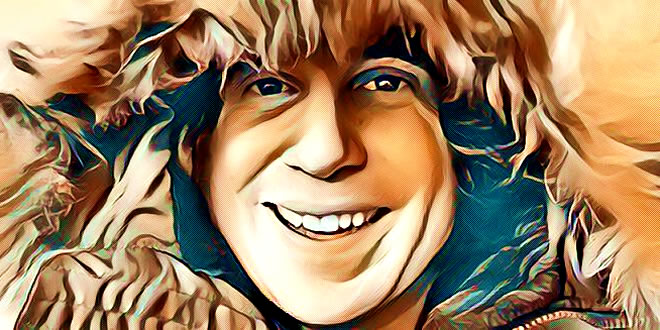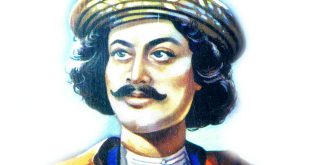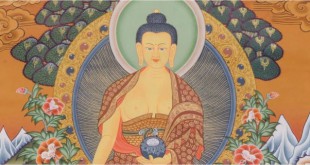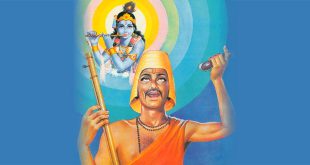| Full Name: | Paul Frederic Simon |
| Birth: | October 13, 1941 Newark, New Jersey, USA |
| Occupation(s): | Musician, Singer, Songwriter, Actor |
| Instruments: | Vocals, Guitar Genres: Folk, Rock, Pop, World |
Through his solo and collaborative work, Simon has earned 13 Grammys, including the Lifetime Achievement Award. In 2001, he was inducted into the Rock and Roll Hall of Fame and in 2006 was selected as one of the “100 People Who Shaped the World” by Time magazine. Among many other honors, Simon was named the first recipient of the Library of Congress’s Gershwin Prize for Popular Song in 2007.
Paul Simon: Early Life & Career
Paul Simon was born in Newark, New Jersey to Jewish Hungarian parents Bella, an elementary school teacher, and Louis Simon, a college professor, bassist, and dance bandleader who performed under the name “Lee Sims”. His father had been one of the first musicians on radio, when he lived in Hungary. In 1941 his family moved to Kew Garden Hills, Queens in New York City.
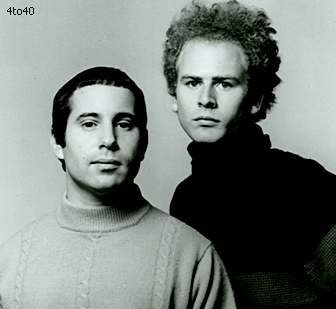 Simon’s musical career began at Forest Hills High School when he and his friend Art Garfunkel began singing together, occasionally performing at school dances. Their idols were the Everly Brothers, whom they imitated in their use of close two-part harmony. Simon also developed an interest in jazz, folk and blues, especially musical legends Woody Guthrie and Lead Belly.
Simon’s musical career began at Forest Hills High School when he and his friend Art Garfunkel began singing together, occasionally performing at school dances. Their idols were the Everly Brothers, whom they imitated in their use of close two-part harmony. Simon also developed an interest in jazz, folk and blues, especially musical legends Woody Guthrie and Lead Belly.
In 1957, while in their mid-teens, Simon and Garfunkel recorded the song “Hey, Schoolgirl” under the name Tom and Jerry, given to them by their label Big Records. The single reached number forty-nine on the pop charts.
After graduating from high school, Simon attended Queens College, while Garfunkel studied at Columbia University in Manhattan. Simon was a brother in the Alpha Epsilon Pi fraternity. Simon earned a degree in English literature and briefly attended Brooklyn Law School, but his real passion was rock and roll.
Between 1957 and 1964, Simon wrote, recorded, and released more than thirty songs, occasionally reuniting with Garfunkel as Tom & Jerry for some singles, including “Our Song” and “That’s My Story”. Most of the songs Simon recorded in the six years after 1957 were performed alone or with musicians other than Garfunkel. They were released on several minor record labels, such as Amy, Big, Hunt, King, Tribute, and Madison. He used several different pseudonyms for these recordings, including Jerry Landis, Paul Kane (from Orson Welles’s film Citizen Kane) and True Taylor. Simon enjoyed some moderate success in recording a few singles as part of a group called Tico and the Triumphs, including a song called “Motorcycle” which reached No. 97 on the Billboard charts in 1962. Tico and the Triumphs released four 45s. Marty Cooper, known as Tico, sang lead on several of these releases. Bobby Susser, children’s songwriter and record producer, and childhood friend of Simon’s, co-produced the Tico 45s with Simon. That year, Simon reached No. 99 on the pop charts as Jerry Landis with the hit “The Lone Teen Ranger.” Both chart singles were released on Amy Records.
In 1965 Simon moved to England and started touring folk clubs and coffee houses. At the first club he played, the Railway Inn Folk Club in Brentwood, Essex, he met Kathy Chitty who became his girlfriend and inspiration for “Kathy’s Song”, “America” and others. He performed at Les Cousins in London and toured provincial folk clubs where he was exposed to a wide range of musical influences. In 1965 he recorded his solo LP The Paul Simon Songbook in England. During his time in the UK Simon co-wrote several songs with Bruce Woodley of the Australian pop group The Seekers including “I Wish You Could Be Here,” “Cloudy”, and “Red Rubber Ball”; Woodley’s co-author credit was incorrectly omitted from “Cloudy” on the Parsley, Sage, Rosemary and Thyme album. The American group The Cyrkle recorded a cover of “Red Rubber Ball”, which reached number two in the US. Simon also contributed to The Seekers catalogue with “Someday One Day,” which was released in March 1966, charting at around the same time as Simon and Garfunkel’s Homeward Bound.
Simon & Garfunkel
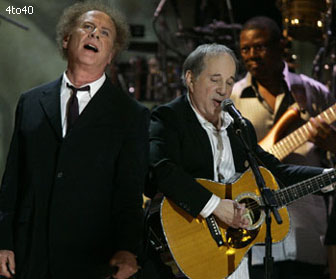 In early 1964, Simon and Garfunkel got an audition with Columbia Records, whose executive Clive Davis was impressed enough to sign the duo to a contract to produce an album. Columbia decided that the two would be called simply “Simon & Garfunkel,” a replacement for the group’s previous name “Tom and Jerry.” Simon claimed in 2003 that this renaming as “Simon & Garfunkel” was the first time that artists’ ethnic names had been used in pop music.
In early 1964, Simon and Garfunkel got an audition with Columbia Records, whose executive Clive Davis was impressed enough to sign the duo to a contract to produce an album. Columbia decided that the two would be called simply “Simon & Garfunkel,” a replacement for the group’s previous name “Tom and Jerry.” Simon claimed in 2003 that this renaming as “Simon & Garfunkel” was the first time that artists’ ethnic names had been used in pop music.
Simon and Garfunkel’s first LP, Wednesday Morning, 3 A.M., was released on October 19, 1964 and comprised twelve songs in the folk vein, five of them written by Simon. The album initially flopped, but East Coast radio stations began receiving requests for one of the tracks, Simon’s “The Sounds of Silence”. Their producer, Tom Wilson, overdubbed the track with electric guitar, bass, and drums, releasing it as a single that eventually went to number one on the pop charts in the USA.
Simon had gone to England in 1965 after the initial failure of Wednesday Morning, 3 A.M., pursuing a solo career. But he returned to the US to reunite with Garfunkel after “The Sounds of Silence” had started to enjoy commercial success. Together they recorded four more influential albums, Sounds of Silence; Parsley, Sage, Rosemary and Thyme; Bookends; and the hugely successful Bridge over Troubled Water. Simon and Garfunkel also contributed extensively to the soundtrack of the 1967 Mike Nichols film The Graduate (starring Dustin Hoffman and Anne Bancroft). While writing “Mrs. Robinson”, Simon originally toyed with the title “Mrs. Roosevelt.” When Garfunkel reported this indecision over the song’s name to the director, Nichols replied, “Don’t be ridiculous! We’re making a movie here! It’s Mrs. Robinson!” Simon and Garfunkel returned to England in the Fall of 1968 and did a concert appearance at Kraft Hall which was broadcast on the BBC, and also featured Paul’s brother Ed sitting in on a performance of the instrumental “Anji”.
Paul Simon – Graceland (from The Concert in Hyde Park)
Simon pursued solo projects after the duo released their popular album Bridge over Troubled Water. Occasionally, he and Garfunkel did reunite, such as in 1975 for their Top Ten single “My Little Town”, which Simon originally wrote for Garfunkel, claiming Garfunkel’s solo output was lacking “bite.” The song was included on their respective solo albums; Paul Simon’s Still Crazy After All These Years, and Garfunkel’s Breakaway. Contrary to popular belief, the song is not at all autobiographical of Simon’s early life in New York City. In 1981, they got together again for the famous concert in Central Park, followed by a world tour and an aborted reunion album Think Too Much, which was eventually released (without Garfunkel) as Hearts and Bones. Together, they were inducted into the Rock and Roll Hall of Fame in 1990.
In 2003, the two reunited again when they received a Grammy Lifetime Achievement Award. This reunion led to a U.S. tour—the acclaimed “Old Friends” concert series—followed by a 2004 international encore, which culminated in a free concert at the Colosseum in Rome. That final concert drew 600,000 people.
1971 – 76
After Simon and Garfunkel split in 1970, Simon began to write and record solo material. His eponymous album Paul Simon was released in January 1972, preceded by his first experiment with world music, the Jamaican-inspired “Mother and Child Reunion”, considered one of the first examples of reggae attempted by a white musician. The single was a hit, reaching both the American and British Top 5. The album was particularly well received, with critics praising the variety of styles and the confessional lyrics, reaching No. 4 in the U.S. and No. 1 on the UK and Japan. It later spawned another Top 30 hit with “Me and Julio Down by the Schoolyard”.
Simon’s next project was the pop-folk masterpiece, There Goes Rhymin’ Simon, released in May 1973. It contained some of his most popular and polished recordings – the lead single, “Kodachrome”, was a No. 2 hit in America, and the follow-up, the gospel-flavored “Loves Me Like a Rock” was even bigger, topping the Cashbox charts. Other songs, like the weary “American Tune” or the melancholic “Something So Right” – a tribute to Simon’s first wife, Peggy – became standards in the musician’s catalogue. Critical and commercial reception for this sophomore album were even stronger than for his debut. The album reached No. 1 on the Cashbox album charts. As a souvenir for the tour that came next, in 1974 it was released as a live album, Live Rhymin’, which was moderately successful and displayed some changes in Simon’s music style, adopting world and religious music.
Highly anticipated, Still Crazy After All These Years was his next album. Released in October 1975 and produced by Simon and Phil Ramone, it marked another departure. The mood of the album was darker, as he wrote and recorded it in the wake of his divorce. Preceded by the feel-good duet with Phoebe Snow, “Gone at Last” (a Top 25 hit) and the Simon & Garfunkel reunion track “My Little Town” (a No. 9 on Billboard), the album managed to be his only No. 1 on the Billboard charts to date. The 18th Grammy Awards named it the Album of the Year and Simon’s performance the year’s Best Male Pop Vocal. With Simon in the forefront of popular music, the third single from the album, “50 Ways to Leave Your Lover” reached the top spot of the Billboard charts, his only single to reach No. 1 on this list. Also, in May 3, 1976, Simon put together a benefit show at Madison Square Garden to raise money for the New York Public Library. Phoebe Snow, Jimmy Cliff and the Brecker Brothers also performed. The concert produced over $30,000 for the Library.
1977 – 85
After three back-to-back successful studio albums, Simon became less productive during the second half of the seventies. He dabbled in various projects, including writing music for the film Shampoo and acting (he was cast as Tony Lacey in Woody Allen’s film Annie Hall). He achieved another hit in this decade, with the lead single of his 1977 compilation, Greatest Hits, Etc., “Slip Slidin’ Away”, reaching No. 5 in America.
In 1980 he released One Trick Pony, his debut album with Warner Bros. Records and his first in almost five years. It was paired with the motion picture of the same name, in which Simon starred. Although it produced his last Top 10 hit with the upbeat “Late in the Evening” (also a No. 1 hit on the Radio & Records American charts), the album did not sell well, in a music market dominated by disco music. Simon recorded Hearts and Bones, a polished and confessional album that was eventually viewed as one of his best works, but that marked a lull in his commercial popularity; both the album and the lead single, “Allergies”, missed the American Top 40. Hearts and Bones included “The Late Great Johnny Ace”, a song partly about Johnny Ace, an American R&B singer, and partly about slain Beatle John Lennon. A successful US solo tour featured Simon and his guitar, with a recording of the rhythm track and horns for “Late In The Evening.” In January 1985, Simon lent his talent to USA for Africa and performed on the relief fundraising single “We Are the World”.
Paul Simon – The Boy In The Bubble (Live from The African Concert, 1987)
1986 – 92
As he commented years later, after the disastrous Hearts and Bones, Simon felt he had lost his inspiration to a point of no return, and that his commercial fortunes were unlikely to change. While driving his car in late 1984 in this state of frustration, Simon listened to a cassette of the Boyoyo Boys’ instrumental “Gumboots”. Interested by the unusual sound, he wrote lyrics to the number which he sang over a re-recording of the song. It was the first composition of a new musical project that became the celebrated album Graceland, an eclectic mixture of musical styles including pop, a cappella, isicathamiya, rock, and mbaqanga. Simon felt that he had nothing to lose. He traveled to South Africa in an attempt to embrace the culture and find the most comfortable environment for recording the album. Sessions in Johannesburg took place in February 1985. Overdubbing and additional recording was done in April, 1986, in New York. The sessions featured many South African musicians and groups, particularly Ladysmith Black Mambazo. Simon also collaborated with several artists of his own culture, singing a memorable duet with Linda Ronstadt in “Under African Skies”, and playing with Los Lobos in “All Around the World or The Myth of the Fingerprints”. Warner Bros. Records had serious doubts about releasing an album of this eclecticism to the mainstream, but when it did in August 1986, Graceland was praised by critics and the public and became Simon’s most successful solo album. Slowly climbing the worldwide charts, it reached #1 in many countries, including the UK, Canada, Australia and New Zealand, and peaked at #3 in the U.S. It was the second-best-selling album of 1987 in the U.S., selling five million copies and eventually reaching 5x Platinum certification. Another seven million copies were sold internationally to become his best-selling album. Much of the success of the album was due to the lead single, the upbeat “You Can Call Me Al”, whose lyrics describe a man experiencing an identity crisis. The track featured many memorable elements – a catchy synthesizer riff, an easy whistle solo, and an unusual bass run in which the second half was a reversed recording of the first half. “You Can Call Me Al” was accompanied with a humorous video featuring actor Chevy Chase, which introduced Simon to a new audience through MTV. In the end, the track reached UK Top 5 and the U.S. Top 25. Further singles, including the title track, “The Boy in the Bubble” and “Diamonds on the Soles of Her Shoes”, were not commercial hits but became radio standards and were highly praised.
At age 45, Simon found himself back at the forefront of popular music. He received the Grammy Awards for Album of the Year in 1987 and also Grammy Award for Record of the Year for the title track one year later. He also embarked on the very successful Graceland Tour, which was documented on music video. Simon found himself embracing new sounds, a fact that some critics viewed negatively – however, Simon reportedly felt it as a very natural artistic experiment, considering that “world music” was already present on much of his early work, including such Simon & Garfunkel hits as “El Condor Pasa”. One way or another, Warner Bros. Records (who by this time now controlled and reissued all his previous Columbia albums) re-established Simon as one of his most successful artists and, in an attempt of capitalize on his renewed success, release the album Negotiations and Love Songs in November 1988, a mixture of greatest hits and personal favourites that covered Simon’s entire career and became an enduring seller in his catalog.
After Graceland, Simon decided to extend his roots with the Brazilian music-flavored The Rhythm of the Saints. Sessions for the album began in December 1989, and took place in Rio de Janeiro and New York, featuring guitarist J. J. Cale and many Brazilian and African musicians. The tone of the album was more introspective and relatively low-key compared to the mostly upbeat numbers of Graceland. Released on October 1990, the album received excellent critical reviews and achieved very respectable sales, peaking at #4 in the U.S. and No. 1 in the UK. The lead single, “The Obvious Child”, featuring the Grupo Cultural Olodum, was a Top 20 hit in the UK and appeared near the bottom of the Billboard Hot 100. Although not as successful as Graceland, The Rhythm of the Saints was received as a competent successor and consistent complement on Simon’s attempts to explore (and popularize) world music, and also received a Grammy nomination for Album of the Year. Here are also more songs about past loves; his ex-wife Carrie Fisher says in her autobiography Wishful Drinking that the song “She Moves On” is about her. It’s one of several she claims, followed by the line, “If you can get Paul Simon to write a song about you, do it. Because he is so brilliant at it.”
The importance of both albums allowed Simon to stage another New York concert, and on August 15, 1991, almost a decade after his concert with Garfunkel, Simon staged another concert in Central Park with both African and South American bands. The success of the concert surpassed all expectations, and reportedly over 750,000 people attended, becoming one of the largest concert audiences in history. He later remembered the concert as the “most memorable moment in my career”. The success of the show led to both a live album and an Emmy-winning TV special. In the middle, Simon embarked on the successful Born at the Right Time Tour and promoted the album with further singles, including “Proof” – accompanied with a humorous video featuring, again, Chevy Chase. On March 4, 1992 he appeared on his own MTV Unplugged, offering renditions of many of his most famous compositions. Broadcast in June, the show was a success, though it did not receive an album release.
1993 – 98
After Unplugged, Simon’s place in the forefront of popular music dropped notably. A Simon & Garfunkel reunion took place in 1993, and in another attempt to capitalize on the occasion, Columbia released Paul Simon 1964/1993 in September, a three-disc compilation that received a reduced version on the two-disc album The Paul Simon Anthology one month later. In 1995 he only made news for appearing at The Oprah Winfrey Show, where he performed the song “Ten Years”, which he composed specially for the tenth anniversary of the show. Also that year, he was featured on the Annie Lennox version of his 1973 song “Something So Right”, which appeared briefly on the UK Top 50 once it was released as a single in November.
Since the early stages of the nineties, Simon was fully involved on The Capeman, a musical that finally opened on January 29, 1998. Simon worked enthusiastically on the project for many years and described it as “a New York Puerto Rican story based on events that happened in 1959—events that I remembered.” The musical tells the story of real-life Puerto Rican youth Salvador Agron, who wore a cape while committing two murders in 1959 New York, and who went on to become a writer in prison. Featuring Marc Anthony as the young Agron and Ruben Blades as the older Agron, the play received terrible reviews and very poor box office receipts from the very beginning, and ended up closing in March 28 after just 68 performances, becoming a failure from which Simon reportedly lost 11 million dollars. The cast album, already released in November 1997, was received with very mixed reviews, though many critics praised the combination of doo-wop, rockabilly and Caribbean music that the album reflected. In commercial terms, Songs from The Capeman was a failure—it found Simon missing the Top 40 of the Billboard charts for the first time in his career.
1999 – 2007
After the disaster of The Capeman, Simon’s career was again in an unexpected crisis. However, entering the new millennium he maintained a respectable reputation, offering critically-acclaimed new material and receiving commercial attention. In 1999, Simon embarked on a North American tour with Bob Dylan where each alternated as headline act with a “middle” section where they performed together, starting on the first of June and ending September 18. The collaboration was generally well-received, with just one critic, Seth Rogovoy, from the Berkshire Eagle, questioning the collaboration.
In an attempt to return successfully to the music market, Simon wrote and recorded a new album very quickly, with You’re the One arriving in October 2000. The album consisted mostly of folk-pop writing combined with foreign musical sounds, particularly grooves from North Africa. While not reaching the commercial heights of previous albums, it managed at least to reach both the British and American Top 20. It received favorable reviews and received a Grammy nomination for Album of the Year. He toured extensively for the album, and one performance in Paris was released to home video.
On September 21, 2001, Simon sang Bridge Over Troubled Water on “America: A Tribute to Heroes”, a multinetwork broadcast to benefit the September 11 Telethon Fund. In 2002, he wrote and recorded “Father and Daughter”, the theme song for the animated children’s movie The Wild Thornberrys Movie, The track was nominated for an Academy Award for Best Song. In 2003, he participed on another Simon & Garfunkel reunion. One year later, Simon’s studio albums were re-released both individually and together in a limited-edition nine-CD boxed set, Paul Simon: The Studio Recordings 1972-2000.
At the time, Simon was already working on a new album with Brian Eno called Surprise, which was released in May 2006. Most of the album was inspired by the September 11 terrorist attacks, the Iraq invasion and the war that followed. In personal terms, Simon was also inspired by the fact of being over sixty years old, an age that he turned in 2001 and that he humorously referred already on his single “Old”, from the You’re the One album. Simon showed specially care about the musical venture he traveled since 1986’s Graceland. As he put it, “Once you go away for a bit, you wonder who people think you are. If they don’t know what you’re up to, they just go by your history. I’m so often described as this person that went to other cultures, which is true, but I never thought of it that way. I suspect people are thinking, ‘What culture did you go to?’ But this record is straight-ahead American.” Surprise was a commercial hit, reaching #14 in the Billboard 200 and #4 in the UK. Most critics also praised the album, and many of them called it a real “comeback” for the artist. Stephen Thomas Erlewine from Allmusic paid attention to the attempts of Simon in embracing his classic folk sound with Eno’s electronic textures, and wrote that “Simon doesn’t achieve his comeback by reconnecting with the sound and spirit of his classic work; he has achieved it by being as restless and ambitious as he was at his popular and creative peak, which makes Surprise all the more remarkable.” The album was supported with the successful Surprise Tour.
On March 1, 2007, Simon made headlines again when he was announced as the first recipient of the recently-created Gershwin Prize for Popular Song. The Prize, created by the Library of Congress, was awarded to Simon during a Concert Gala featuring his music at the Warner Theatre in Washington, D.C., on the evening of May 23. The event was nationally broadcast on PBS on the evening of June 27, 2007. Performers at the concert included Shawn Colvin, Philip Glass, Alison Krauss, Ladysmith Black Mambazo, Lyle Lovett, James Taylor, and Stevie Wonder as well as Simon’s former collaborator Art Garfunkel. On June 26, Warner Bros. released the definitive Paul Simon greatest-hits collection. The Essential Paul Simon consisted of two discs that reviewed 36 songs from his ten studio albums, and was also released on a special edition featuring a DVD of music videos and memorable live performances. The album was a commercial hit, reaching #12 in the UK.
Paul Simon resides in New Canaan, Connecticut. He is one of a small number of performers who are named as the copyright owner on their recordings (most records have the recording company as the named owner of the recording). This noteworthy development was spearheaded by the Bee Gees after their successful $200 million lawsuit against RSO Records, which remains to this day the largest successful lawsuit against a record company by an artist or group.
All of Simon’s solo recordings, even the ones originally issued by Columbia Records, are currently distributed by Sony Records’ Legacy Recordings unit. His recordings were issued by Warner Music until mid-2010.
Simon is also one of the practitioners of a creative and distinctive fingerstyle guitar style in popular music. His instrumental proficiency (influenced by British guitarist Davey Graham as evidenced by his cover of Graham’s very difficult “Anji” on Sounds of Silence) has always been highly underrated and practically invisible as a guitarist. His Cole Porter-esque compositional abilities with his combination of jazz-tinged chords and seamless, romantic, poetic lyrics ranged throughout all his different songwriting styles.
In February 2009, Simon performed back-to-back shows in his native New York City at the Beacon Theatre, which had recently been renovated. Simon was reunited with Art Garfunkel at the first show as well as with the cast of The Capeman; also playing in the band was Graceland bassist Bakithi Kumalo.
In May 2009, Simon toured with Art Garfunkel in Australia, New Zealand and Japan.
In October 2009, Simon appeared alongside Art Garfunkel at the 25th Anniversary of The Rock & Roll Hall of Fame concert at Madison Square Garden in New York City. The pair performed four of their most popular songs, “The Sounds of Silence”, “The Boxer”, “Cecilia”, and “Bridge Over Troubled Water”.
On April 21, 2010 it was announced that Paul Simon would be an honorary degree recipient at the Brandeis University Commencement ceremony to be held on May 23, 2010. Due to student interest expressed through Facebook, Simon performed “The Boxer” at the 59th Commencement Exercises at the University.
Simon is working on a new album due for a late 2010 release. The album will have bluegrass influence. On June 1, 2010 it was reported that Paul Simon was attempting to have Bob Dylan guest on the new album. In reference to the new album, Simon claims, “It’s the best work I’ve done in 20 years.” In mid-2010, Simon moved his catalogue of solo work from Warner Bros. Records to Sony/Columbia Records where Simon and Garfunkel’s catalogue is. Simon’s back catalogue of solo recordings would be marketed by Sony Music’s Legacy Recordings unit.
Music for Broadway
 In the late 1990s, he also wrote and produced a Broadway musical called The Capeman, which lost $11 million during its 1998 run. In April 2008, the Brooklyn Academy of Music celebrated Paul Simon’s works, and dedicated a week to Songs From the Capeman with a good portion of the show’s songs performed by a cast of singers and the Spanish Harlem Orchestra. Simon himself appeared during the BAM shows, performing “Trailways Bus” and “Late In the Evening”.
In the late 1990s, he also wrote and produced a Broadway musical called The Capeman, which lost $11 million during its 1998 run. In April 2008, the Brooklyn Academy of Music celebrated Paul Simon’s works, and dedicated a week to Songs From the Capeman with a good portion of the show’s songs performed by a cast of singers and the Spanish Harlem Orchestra. Simon himself appeared during the BAM shows, performing “Trailways Bus” and “Late In the Evening”.
Film and Television
Simon has also dabbled in acting. He played music producer Tony Lacey in the 1977 Woody Allen film Annie Hall, and wrote and starred in 1980’s One Trick Pony as Jonah Levin, a journeyman rock and roller. Simon also wrote all the songs in the film. Paul Simon also appeared on The Muppet Show (the only episode to use only the songs of one songwriter, Simon). In 1990, he played the character Simple Simon on the Disney channel TV movie, Mother Goose Rock ‘n’ Rhyme.
Simon has also appeared on Saturday Night Live (SNL) either as host or musical guest for a total of 12 times. On one appearance in the late 1980s, he worked with his political namesake, Illinois Senator Paul Simon.
His most recent SNL appearance was the May 13, 2006 episode hosted by Julia Louis-Dreyfus. He performed two new songs from his Surprise album, “How Can You Live in the Northeast?” and “Outrageous”. In one SNL skit from 1986 (when he was promoting Graceland), Simon plays himself, waiting in line with a friend to get into a movie. He amazes his friend by remembering intricate details about prior meetings with passers-by, but draws a complete blank when approached by Art Garfunkel, despite the latter’s numerous memory prompts.
Simon also appeared alongside George Harrison as musical guest on the Thanksgiving Day episode of SNL (November 20, 1976). The two performed “Here Comes the Sun” and “Homeward Bound” together, while Simon performed “50 Ways to Leave Your Lover” solo earlier in the show. On that episode, Simon opened the show singing “Still Crazy After All These Years” in a turkey outfit, since Thanksgiving was the following week. About halfway through the song, Simon tells the band to stop playing because of his embarrassment. After giving a frustrating speech to the audience, he leaves the stage, backed by applause. Lorne Michaels positively greets him backstage, but Simon is still upset, yelling at him because of the humiliating turkey outfit. This is one of SNL’s most played sketches.
On September 29, 2001, Simon made a special appearance on the first SNL to air after the September 11, 2001 attacks. On that show, he performed “The Boxer” to the audience and the NYC firefighters and police officers. He is also friends with former SNL star Chevy Chase, who appeared in his video for “You Can Call Me Al” lip synching the song while Simon looks disgruntled and mimes backing vocals and the playing of various instruments beside him. He is a close friend of SNL producer Lorne Michaels, who produced the 1977 TV show The Paul Simon Special, as well as the Simon and Garfunkel concert in Central Park four years later. Simon and Lorne Michaels were the subjects of a 2006 episode of the Sundance channel documentary series, Iconoclasts.
He has been the subject of two films by Jeremy Marre, the first on Graceland, the second on The Capeman.
On November 18, 2008, Simon was a guest on The Colbert Report promoting his book Lyrics 1964-2008. He did an interview with Stephen Colbert and then performed “American Tune”.
Simon performed a Stevie Wonder song at the White House in 2009, at an event honoring Wonder’s musical career and contributions, hosted by President Barack Obama.
In May 2009, The Library of Congress: Paul Simon and Friends Live Concert was released on DVD, via Shout! Factory. The PBS concert was recorded in 2007.
Awards & Honors
Paul Simon won 12 Grammy Awards (one of them a Lifetime Achievement Award) and five Grammy nominations, the most recent for his album You’re the One in 2001. In 1998 he received a Grammy Hall of Fame Award for the Simon & Garfunkel album Bridge over Troubled Water. He received an Oscar nomination for the song “Father and Daughter” in 2002.
In 2001 Paul Simon was honored as MusiCares Person Of The Year.
Paul Simon is a two-time inductee into the Rock and Roll Hall of Fame — as a solo artist in 2001, and in 1990 as half of Simon & Garfunkel.
In 2002, Paul Simon was one of the five annual recipients of the Kennedy Center Honors, the nation’s highest tribute to performing and cultural artists.
In 2005, he received the Top Award of the 53rd Annual BMI Pop Awards. His songwriting catalog has earned 39 BMI Awards including multiple citations for “Bridge Over Troubled Water,” “Mrs. Robinson,” “Scarborough Fair” and “The Sound of Silence” and amassed nearly 75 million broadcast airplays, according to BMI surveys.
In 2006, Paul Simon was selected by Time Magazine as one of the “100 People Who Shaped the World.”
Paul Simon received the first annual Library of Congress Gershwin Prize for Popular Song in 2007. Stevie Wonder and Paul McCartney were to follow in 2009 and 2010. Named in honor of the legendary George and Ira Gershwin, this newly created award recognizes the profound and positive effect of popular music on the world’s culture. Upon being notified of receiving this honor, Simon said, “I am grateful to be the recipient of the Gershwin Prize and doubly honored to be the first. I look forward to spending an evening in the company of artists I admire at the award ceremony in May. I can think of a few who have expressed my words and music far better than I. I’m excited at the prospect of that happening again. It’s a songwriter’s dream come true.” Among the performers who paid tribute to Simon were Stevie Wonder, Alison Krauss, Lyle Lovett, James Taylor, Dianne Reeves, Marc Anthony, Yolanda Adams, and Ladysmith Black Mambazo. The event is professionally filmed, broadcasted and now available as Paul Simon and Friends.
In 2010, Paul Simon received an honorary degree from Brandeis University, where he also performed “The Boxer” at the main commencement ceremony.
Personal Life
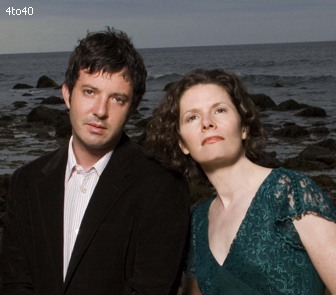 Simon has been married three times, first to Peggy Harper in late autumn 1969. They had a son, Harper Simon, in 1972 and divorced in 1975. The song “Train in the Distance,” from Simon’s 1983 album, is about this relationship. Simon’s 1972 song “Run That Body Down,” from his debut solo album, casually mentions both himself and his then-wife (“Peg”) by name. His second marriage, from 1983 to 1984, was to actress and author Carrie Fisher to whom he proposed after a New York Yankees game. The song “Hearts and Bones” was written about this relationship. He married folk singer Edie Brickell on May 30, 1992. They have three children together. Though Simon is left-handed, he plays the guitar right-handed.
Simon has been married three times, first to Peggy Harper in late autumn 1969. They had a son, Harper Simon, in 1972 and divorced in 1975. The song “Train in the Distance,” from Simon’s 1983 album, is about this relationship. Simon’s 1972 song “Run That Body Down,” from his debut solo album, casually mentions both himself and his then-wife (“Peg”) by name. His second marriage, from 1983 to 1984, was to actress and author Carrie Fisher to whom he proposed after a New York Yankees game. The song “Hearts and Bones” was written about this relationship. He married folk singer Edie Brickell on May 30, 1992. They have three children together. Though Simon is left-handed, he plays the guitar right-handed.
Philanthropy
Simon is a proponent of music education for children. In 1970, after recording his “Bridge Over Troubled Water”, at the invitation of the NYU School of the Arts, Simon held auditions for a young songwriter’s workshop. Advertised in the Village Voice, the auditions brought hundreds of hopefuls to perform for Simon. Among the six teenage songwriters Simon selected for tutelage were Melissa Manchester, Tom Mandell and rockbeat poet joe Linus, with Maggie and Terre Roche (the Roche Sisters), who later sang back-up for Simon, joining the workshop in progress through an impromptu appearance. Simon invited the six teens to experience recording at Columbia studios with engineer Roy Halee at the board. During these sessions, Bob Dylan was downstairs recording Self-Portrait, which included a version of Simon’s “The Boxer”. Violinist Isaac Stern also visited the group with a CBS film crew, speaking to the young musicians about lyrics and music after Joe Linus performed his song “Circus Lion” for Mr Stern. Melissa Manchester later paid homage to Simon, on her recorded song, “Ode to Paul.” Other younger musicians Simon has mentored include Nick Laird-Clowes, who later co-founded the band The Dream Academy. Laird-Clowes has credited Simon with helping to shape the band’s biggest hit, “Life In A Northern Town”.
In 2003, Simon signed on as an official supporter of Little Kids Rock, a nonprofit organization that provides free musical instruments and free lessons to children in public schools throughout the U.S. He sits on the organization’s board of directors as an honorary member. Paul Simon is also a major benefactor and one of the co-founders, with Dr. Irwin Redlener, of the Children’s Health Project and The Children’s Health Fund which started by creating specially equipped “buses” to take medical care to children in medically under served areas, urban and rural. Their first bus was in the impoverished South Bronx of New York City but they now operate in 12 states, including the Gulf Coast. It has expanded greatly, partnering with major hospitals, local public schools and medical schools and advocating policy for children’s health and medical care.
 Kids Portal For Parents India Kids Network
Kids Portal For Parents India Kids Network
